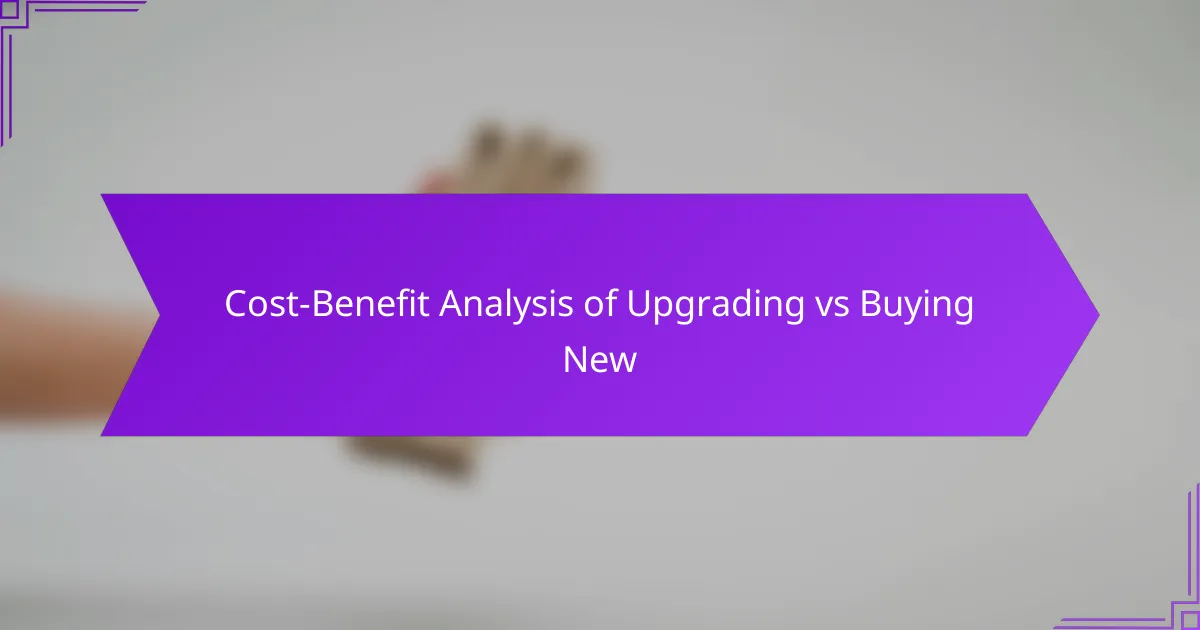Understanding the long-term ownership costs of vehicles is essential for prospective buyers, as these expenses can greatly affect the overall financial commitment. Factors such as depreciation, maintenance, insurance, and fuel efficiency play crucial roles in determining these costs. By considering the specific vehicle type and individual driving habits, owners can better anticipate their expenses and make informed decisions that align with their budgets.
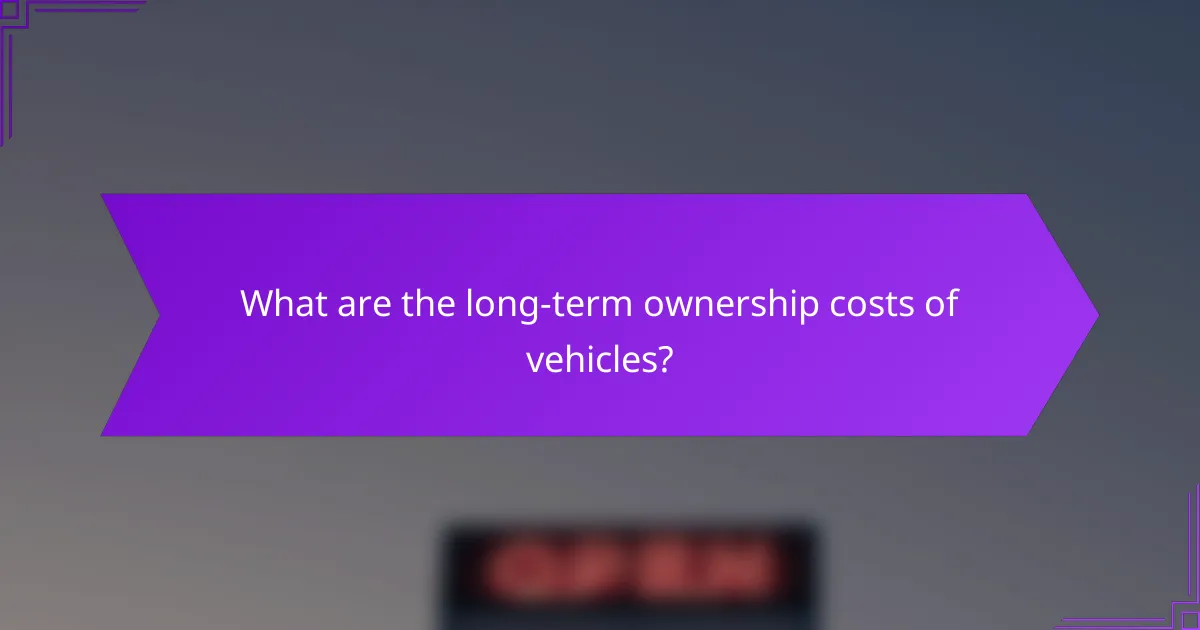
What are the long-term ownership costs of vehicles?
The long-term ownership costs of vehicles encompass various expenses that accumulate over time, significantly impacting the total cost of ownership. Key factors include depreciation, maintenance, insurance, fuel, and financing charges, each contributing to the overall financial commitment of owning a vehicle.
Depreciation rates
Depreciation refers to the reduction in a vehicle’s value over time, typically influenced by age, mileage, and market demand. On average, new cars can lose about 20-30% of their value within the first year and around 50-60% over five years.
When considering a vehicle purchase, it’s essential to research the specific model’s depreciation trends. Some brands and models hold their value better than others, which can significantly affect your long-term costs.
Maintenance expenses
Maintenance expenses include routine services, repairs, and parts replacement necessary to keep a vehicle in good working condition. On average, owners might spend several hundred to over a thousand dollars annually on maintenance, depending on the vehicle’s age and make.
To minimize maintenance costs, consider purchasing vehicles known for reliability and lower repair costs. Regular maintenance can prevent more significant issues and expenses down the line.
Insurance premiums
Insurance premiums are recurring costs that vary based on factors like the vehicle’s make and model, the owner’s driving history, and location. On average, U.S. drivers pay around $1,000 to $1,500 annually for car insurance, but this can vary widely.
To manage insurance costs, shop around for quotes from different providers and consider factors like deductibles and coverage levels. Maintaining a clean driving record can also help lower premiums over time.
Fuel costs
Fuel costs are a significant ongoing expense for vehicle owners, influenced by fuel prices and the vehicle’s fuel efficiency. Depending on driving habits and local fuel prices, owners might spend anywhere from a few hundred to several thousand dollars annually on fuel.
To reduce fuel costs, consider vehicles with higher fuel efficiency ratings or explore alternative fuel options. Regular maintenance, such as tire inflation and engine checks, can also improve fuel economy.
Financing charges
Financing charges arise when a vehicle is purchased through a loan or lease, typically involving interest payments over the loan term. Depending on the loan amount and interest rate, these charges can add hundreds to thousands of dollars to the total cost of ownership.
To minimize financing charges, aim for a larger down payment and shop for the best interest rates. Understanding loan terms and comparing offers can lead to significant savings over the life of the loan.
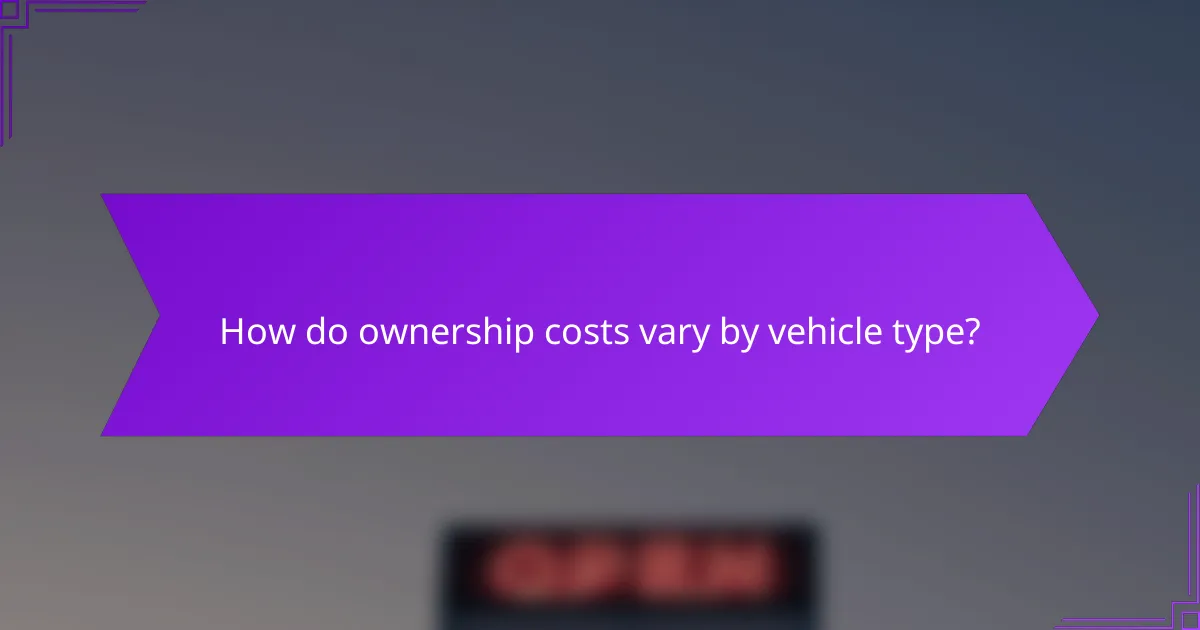
How do ownership costs vary by vehicle type?
Ownership costs differ significantly by vehicle type, influenced by factors such as fuel efficiency, maintenance needs, and insurance rates. Understanding these variations helps potential buyers make informed decisions based on their budget and driving habits.
Costs for electric vehicles
Electric vehicles (EVs) typically have lower long-term ownership costs compared to traditional gasoline cars. Their reduced fuel costs, often less than half of gasoline prices per mile, and lower maintenance requirements contribute to this advantage.
However, initial purchase prices for EVs can be higher, though government incentives may offset this. Additionally, charging infrastructure and home charging setup can impact overall costs, so consider local charging options when evaluating expenses.
Costs for hybrid vehicles
Hybrid vehicles combine gasoline and electric power, leading to moderate ownership costs. They generally offer better fuel efficiency than traditional vehicles, resulting in lower fuel expenses over time.
Maintenance costs can be slightly higher due to the complexity of hybrid systems, but they often qualify for tax incentives. Buyers should weigh the initial cost against potential savings on fuel and maintenance when considering a hybrid.
Costs for SUVs
SUVs tend to have higher ownership costs due to their larger size and weight, which can lead to increased fuel consumption. While many modern SUVs are designed for better fuel efficiency, they still typically consume more fuel than smaller vehicles.
Insurance rates for SUVs can also be higher, reflecting their value and safety ratings. Buyers should assess their driving needs and consider the trade-offs between space and cost when choosing an SUV.
Costs for sedans
Sedans generally have lower ownership costs compared to SUVs and hybrids, primarily due to better fuel efficiency and lower insurance premiums. Their compact size often results in reduced maintenance costs as well.
When evaluating sedans, consider the balance between purchase price and long-term savings on fuel and maintenance. They are often a practical choice for budget-conscious drivers looking for reliable transportation.
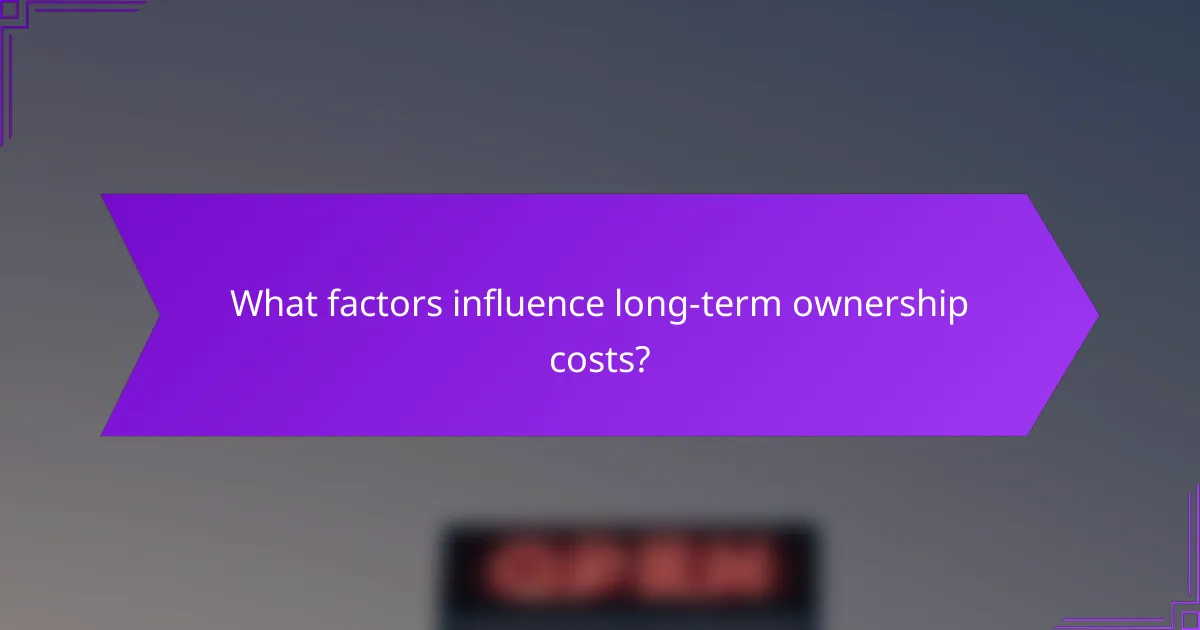
What factors influence long-term ownership costs?
Long-term ownership costs are influenced by various factors including the vehicle make and model, driving habits, geographic location, and market trends. Understanding these elements can help owners anticipate expenses and make informed decisions about their vehicles.
Vehicle make and model
The make and model of a vehicle significantly impact long-term ownership costs. Luxury brands often have higher maintenance and repair costs compared to economy models. Additionally, vehicles known for reliability, such as certain Japanese brands, may incur lower costs over time due to fewer repairs.
When considering a vehicle, research its historical reliability ratings and average repair costs. Tools like consumer reports or automotive forums can provide insights into which makes and models are cost-effective over the long haul.
Driving habits
Driving habits play a crucial role in determining long-term ownership costs. Aggressive driving can lead to increased fuel consumption and higher wear and tear on the vehicle, resulting in more frequent repairs. Conversely, smooth driving can enhance fuel efficiency and prolong the lifespan of the vehicle.
To minimize costs, adopt fuel-efficient driving practices such as maintaining steady speeds and avoiding rapid acceleration. Regular maintenance, like timely oil changes and tire rotations, also contributes to lower long-term expenses.
Geographic location
Your geographic location affects long-term ownership costs through factors like climate, road conditions, and local regulations. For instance, vehicles in regions with harsh winters may require more frequent maintenance due to salt corrosion and battery issues. Similarly, urban areas may see higher insurance rates and parking fees.
Consider local fuel prices, insurance costs, and any emissions regulations that may apply to your vehicle. Understanding these regional factors can help you budget more accurately for ownership costs.
Market trends
Market trends can influence long-term ownership costs by affecting resale values and maintenance expenses. For example, a surge in demand for electric vehicles may lead to increased prices for parts and services related to traditional combustion engines.
Stay informed about market trends by following automotive news and industry reports. This knowledge can help you make strategic decisions about when to buy or sell your vehicle, potentially saving you money in the long run.

How can consumers reduce long-term ownership costs?
Consumers can reduce long-term ownership costs by making informed choices about their vehicles, maintaining them properly, and leveraging available warranties and insurance options. These strategies can significantly lower expenses related to fuel, repairs, and insurance premiums over time.
Choosing fuel-efficient models
Selecting fuel-efficient vehicles is one of the most effective ways to minimize long-term ownership costs. Models that achieve higher miles per gallon (MPG) can lead to substantial savings on fuel, especially as prices fluctuate. For instance, a car that averages 30 MPG compared to one that averages 20 MPG can save hundreds of dollars annually in fuel costs.
When considering fuel efficiency, look for vehicles with hybrid or electric options, as they often have lower operating costs. Additionally, check for government incentives or tax credits that may apply to energy-efficient vehicles, which can further reduce overall expenses.
Regular maintenance practices
Implementing regular maintenance practices is crucial for extending the lifespan of a vehicle and avoiding costly repairs. Simple actions like oil changes, tire rotations, and brake inspections can prevent more significant issues down the line. Following the manufacturer’s maintenance schedule can help keep the vehicle in optimal condition.
Consider setting reminders for routine checks and using a trusted mechanic to ensure quality service. Neglecting maintenance can lead to decreased performance and higher repair costs, so staying proactive is essential.
Utilizing warranties
Warranties can significantly reduce long-term ownership costs by covering repairs and replacements for specific components. When purchasing a vehicle, review the warranty options available, including powertrain and bumper-to-bumper coverage. Understanding what is included can help you avoid unexpected expenses.
For used vehicles, consider purchasing an extended warranty if the original coverage has expired. This can provide peace of mind and financial protection against major repairs, especially for older models.
Comparing insurance providers
Comparing insurance providers is vital for finding the best rates and coverage options, which can lead to significant savings. Different insurers offer varying premiums based on factors like vehicle type, driving history, and coverage levels. Regularly reviewing and comparing quotes can help ensure you are getting the best deal.
Utilize online comparison tools to evaluate multiple providers quickly. Additionally, inquire about discounts for safe driving, bundling policies, or low mileage, as these can further reduce your insurance costs over time.
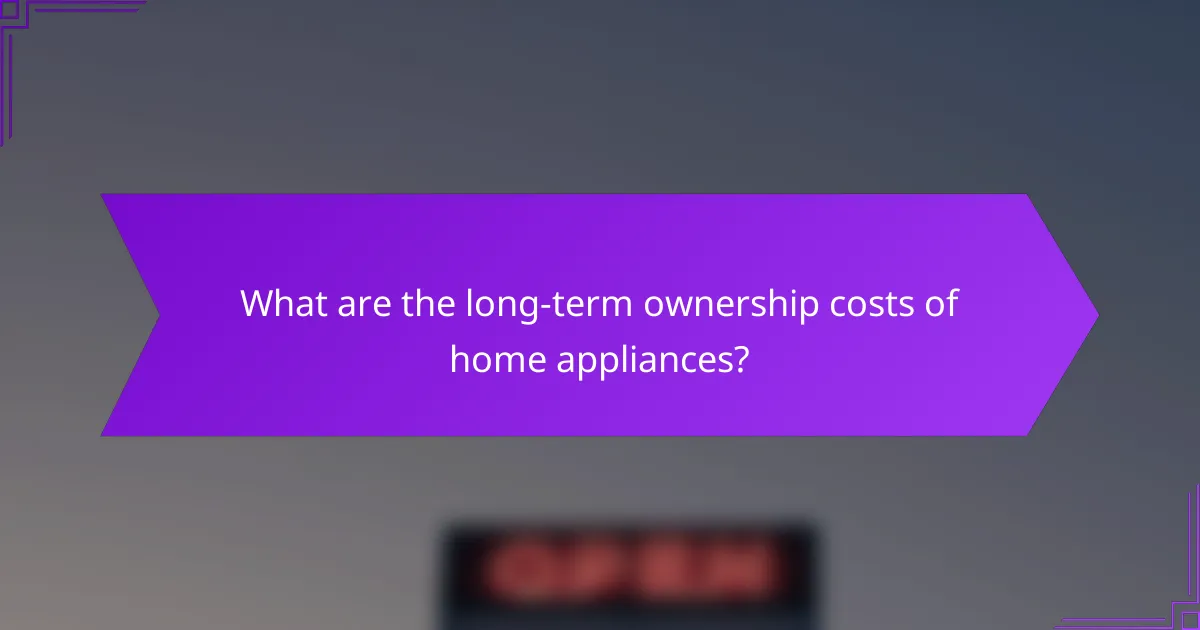
What are the long-term ownership costs of home appliances?
The long-term ownership costs of home appliances include expenses related to energy consumption, repair, and maintenance over time. Understanding these costs helps consumers make informed decisions about their purchases and manage their budgets effectively.
Energy consumption
Energy consumption is a significant factor in the long-term ownership costs of home appliances. Appliances with high energy efficiency ratings, such as those labeled with ENERGY STAR, can save users substantial amounts on their utility bills over their lifespan. For example, a refrigerator that consumes less energy can lead to savings of several hundred dollars over ten years.
When selecting appliances, consider their energy usage in kilowatt-hours (kWh) and compare it to similar models. This allows you to estimate annual operating costs and choose options that align with your budget and energy-saving goals.
Repair and maintenance
Repair and maintenance costs can vary widely depending on the type of appliance and its usage. Regular maintenance, such as cleaning filters and checking seals, can prolong the life of appliances and reduce the likelihood of costly repairs. For instance, maintaining a washing machine may only require minor expenses, while a malfunctioning oven could lead to more significant repair bills.
It’s advisable to set aside a small percentage of the appliance’s purchase price annually for potential repairs. This proactive approach can help mitigate unexpected costs and ensure that you are prepared for any necessary maintenance throughout the appliance’s life.


